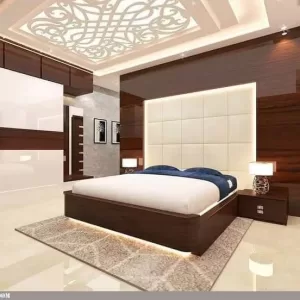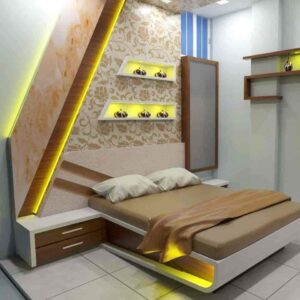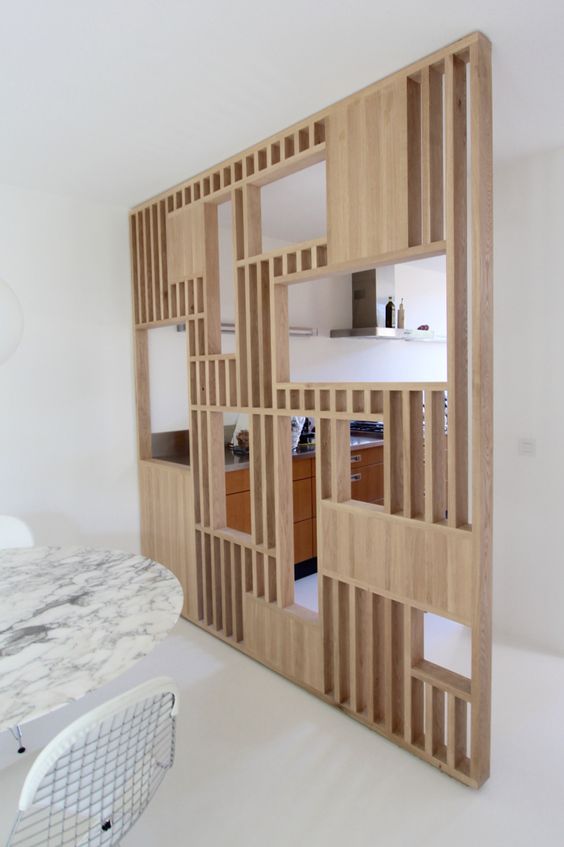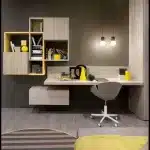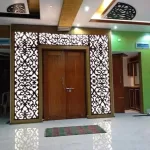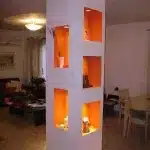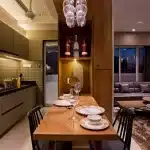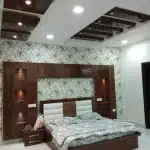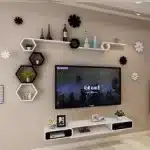Multi-Functional Creative Interior Design: Maximizing Space and Style
In modern living, especially in urban environments where space is often limited, multi-functional interior design has become a trend that emphasizes versatility, creativity, and efficiency. The idea behind multi-functional creative interior design is to make the most out of every square foot of space, ensuring that it serves multiple purposes without sacrificing style. Whether you live in a small apartment or just want to optimize your home, multi-functional design solutions can transform how you use your space.
In this blog, we will explore some of the best ideas, tips, and strategies for creating a multi-functional and creative interior, which combines practicality with aesthetic appeal.
1. The Basics of Multi-Functional Interior Design
Multi-functional design focuses on incorporating versatile furniture, smart layouts, and clever storage solutions to make a living space adaptable to various needs. It’s particularly useful for smaller spaces or those with open floor plans, where rooms serve more than one purpose.
Key Features:
- Dual-purpose Furniture: Furniture that can perform multiple functions is the cornerstone of multi-functional interiors. For example, a sofa that turns into a bed or a dining table that doubles as a desk.
- Flexible Layouts: Create layouts that allow you to quickly adapt a room for different activities, whether it’s work, relaxation, or entertainment.
- Smart Storage: Hidden storage options allow you to keep things organized without sacrificing space. Think of built-in cabinets, storage ottomans, and multifunctional shelving.
2. Transformable Furniture Pieces
Furniture is often the largest investment in any home, so why not ensure it works for you? Transformable furniture is perfect for maximizing space without sacrificing comfort or style.
Sofa Beds and Murphy Beds:
Sofa beds and Murphy beds are perhaps the most popular examples of furniture that serves more than one purpose. A sofa that converts into a comfortable bed allows you to make use of the living room for guests without sacrificing sleep space.
- Pro Tip: Choose a sofa bed with a high-quality mattress to ensure comfort for both sitting and sleeping.
- Pro Tip: Murphy beds can be installed in home offices, freeing up space during the day while providing a comfy sleep area at night.
Foldable Dining Tables:
In smaller apartments, dining tables can often take up too much space. A foldable dining table allows you to pull out the table when needed and fold it away when not in use.
- Pro Tip: Choose a wall-mounted or extendable dining table to save floor space and make it easier to accommodate extra guests when necessary.
Storage Ottomans and Tables:
Ottomans that double as coffee tables or side tables that offer storage are great for making your space look clean and organized while maintaining its functionality.
- Pro Tip: Opt for a large, cushioned ottoman with an upholstered top to make it both a practical coffee table and a cozy seating area.
3. Creative and Flexible Room Layouts
In a multi-functional interior, room layouts are essential. You need to consider how each space can serve various purposes, especially in an open-plan space.
Use of Partitions and Room Dividers:
In open-plan spaces or studio apartments, partitions can be used to create distinct zones without building permanent walls. Consider movable or foldable partitions, curtains, or bookcases that can help define areas like a home office, a sleeping nook, or a dining space.
- Pro Tip: Use curtains or screens instead of solid walls to separate spaces temporarily. This allows for a more fluid transition between areas.
- Pro Tip: A bookshelf can double as a room divider while providing additional storage for books, décor, and other essentials.
Modular Furniture:
Modular furniture allows you to rearrange and reconfigure your space depending on your needs. Modular sofas, bookshelves, and storage units can be mixed and matched to create various setups.
- Pro Tip: Choose modular pieces with interchangeable parts that suit your lifestyle. For example, a sofa with sections that can be moved around to create a sectional or be broken down into smaller parts.
4. Maximizing Vertical Space
Vertical space is often underutilized in many homes. The walls provide an opportunity for creative storage and design that doesn’t take up floor space.
Wall-Mounted Storage:
Wall-mounted shelves, cabinets, and floating shelves can help free up floor space while providing ample storage for books, plants, and decorative items.
- Pro Tip: Install wall-mounted units in the kitchen or bathroom for extra storage without crowding counters and sinks.
- Pro Tip: Use open shelving in the living room to display your favorite décor while keeping the space organized.
Hanging Lighting Fixtures:
Instead of using bulky floor lamps or table lamps, hanging light fixtures such as pendant lights or chandeliers can help illuminate the space without taking up valuable surface area.
- Pro Tip: Use adjustable lighting options, such as dimmable pendant lights, to change the mood and functionality of a space depending on the time of day.
5. Smart Storage Solutions
In any multi-functional space, smart storage is essential to maintain a tidy and organized environment. Here are some creative storage ideas to maximize the space in your home:
Under-Bed Storage:
Beds with built-in drawers or high clearance provide the perfect space for storing seasonal items, extra bedding, or clothing. Use this hidden storage to declutter your room and keep your space functional.
- Pro Tip: If your bed doesn’t have storage underneath, consider using rolling bins or storage boxes that can easily slide under the bed.
Hidden Cabinets and Drawers:
Built-in storage in the form of hidden cabinets and drawers can create extra storage without taking up floor space. For example, use hidden compartments under stairs or within walls to store everyday items.
- Pro Tip: In smaller kitchens or bathrooms, opt for pull-out cabinets or drawers that help you store items neatly while saving on counter space.
Multi-Functioning Shelving:
Shelving units that combine storage and display space can be used for books, plants, and other decorative objects while also providing functional storage behind closed doors or drawers.
- Pro Tip: Combine open and closed shelving to store everyday items behind doors while keeping decorative pieces like books or artwork out in the open.
6. Smart Technology Integration
Modern interior design increasingly includes smart technology that can add functionality and convenience to your home. These smart devices can contribute to a more efficient and comfortable living space.
Smart Furniture:
Some innovative furniture pieces include built-in charging stations, USB ports, or even Bluetooth speakers, offering convenience in small, multifunctional spaces.
- Pro Tip: Look for furniture that integrates power outlets, so you can charge your devices without adding more cables or taking up precious counter space.
Smart Lighting:
Smart lighting systems allow you to adjust the ambiance of your apartment with ease. Dimmable lights, color-changing bulbs, and automated lighting can help set the right mood for any occasion.
- Pro Tip: Install motion-sensing lights in high-traffic areas like hallways or closets to ensure light is available when needed but doesn’t remain on unnecessarily.
Voice-Controlled Devices:
With voice-activated assistants, like Amazon Alexa or Google Home, you can control lights, appliances, and even order groceries, creating a seamless experience in a multi-functional home.
- Pro Tip: Use smart thermostats and home automation systems to control heating and cooling efficiently, optimizing your space.
7. Embracing Minimalism
While multi-functional design is about making the most of your space, minimalism is about reducing clutter and only keeping what’s essential. The two go hand-in-hand.
Simple Aesthetic:
A minimalist aesthetic that emphasizes clean lines and simple furniture pieces works perfectly for a multi-functional space. When every item has a purpose and is well-organized, your home will feel more spacious and serene.
- Pro Tip: Choose furniture with neutral tones and sleek designs to ensure that your space remains clutter-free and versatile.
- Pro Tip: Avoid over-decorating. Instead, let key pieces stand out and use thoughtful details like subtle artwork, elegant light fixtures, and a few statement plants.
Conclusion
The key to a successful multi-functional creative interior lies in striking a balance between aesthetics and practicality. By incorporating versatile furniture, making use of vertical space, maximizing storage, and embracing smart technologies, you can create a home that not only looks stylish but also functions well for all of your needs. Multi-functional design isn’t just about squeezing more into your space – it’s about creating a living environment that reflects your lifestyle while remaining efficient, organized, and beautiful.
With these innovative ideas, you can transform your apartment, home, or office into a functional, creative, and inspiring space, no matter the size or shape of the room.

